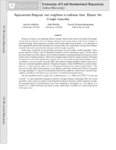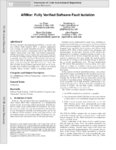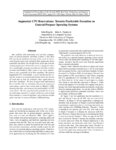Filters: Department: "Computing, School of" School Or College: "College of Engineering" Collection: "ir_uspace"
| Creator | Title | Description | Subject | Date | ||
|---|---|---|---|---|---|---|
| 101 |
 |
Riesenfeld, Richard F. | The application of total positivity to computer aided curve and surface design | Of particular importance in an interactive curve and surface design system is the interface to the user. The mathematical model employed in the system must be sufficiently flexible for interaction between designer and machine to converge to a satisfactory result. The mathematical theory of Total Pos... | interactive curves; total positivity | 1979 |
| 102 |
 |
Jacobson, Hans; Gopalakrishnan, Ganesh | Application specific asynchronous microengines for efficient high-level control | Despite the growing interest in asynchronous circuits programmable asynchronous controllers based on the idea of microprogramming have not been actively pursued Since programmable control is widely used in many commercial ASICs to allow late correction of design errors to easily upgrade product f... | Asynchronous microengines | 1997 |
| 103 |
 |
Jacobson, Hans | Application specific asynchronous microgengines for efficient high-level control | Despite the growing interest in asynchronous circuits, programmable asynchronous controllers based on the idea of microprogramming have not been actively pursued. Since programmable control is widely used in many commercial ASICs to allow late correction of design errors, to easily upgrade product ... | Asynchronous microgengines; Programmable asynchronous controllers | 1997 |
| 104 |
 |
Venkatasubramanian, Suresh | Approximate Bregman near neighbors in sublinear time: beyond the triangle inequality | Bregman divergences are important distance measures that are used extensively in data-driven applications such as computer vision, text mining, and speech processing, and are a key focus of interest in machine learning. Answering nearest neighbor (NN) queries under these measures is very important i... | 2012-01-01 | |
| 105 |
 |
Henderson, Thomas C. | Arc and path consistency revisited | Mackworth and Freuder have analyzed the time complexity of several constraint satisfaction algorithms [4]. We present here new algorithms for arc and path consistency and show that the arc consistency algorithm is optimal in time complexity and of the same order space complexity as the earlier algor... | Arc consistency; Path consistency; Constraint satisfaction algorithms | 1985 |
| 106 |
 |
Wehrli, Robert | ARCAID: The ARChitects computer graphics AID | ARCAID?The ARChitect's Computer Graphics AID?is one part of a two-part research program at the University of Utah under the direction of David C. Evans. ARCAID is a specification for the organization of computer processes including data and procedures for the use of architects, engineers, and other... | ARCAID | 1970 |
| 107 |
 |
Balasubramonian, Rajeev | Architecting efficient interconnects for large caches with CACTI 6.0 | Efficiently executing multithreaded applications on future multicores will require fast intercore communication. Most of this communication happens via reads and writes to large shared caches in the memory hierarchy. Microprocessor performance and power will be strongly influenced by the long inter... | Interconnects; CACTI 6.0; Non-uniform cache architectures (NUCA) | 2008-01 |
| 108 |
 |
Davis, A.L. | The architecture of DDMl: a recursively structured data driven machine | An architecture for a highly modular, recursively structured class of machines is presented. DDMl is an instance of such a machine structure, and is capable of executing machine language programs which are data driven (data flow) nets. These nets may represent arbitrary amounts of concurrency as wel... | DDMl; machine structure; machine language programs | 1977 |
| 109 |
 |
Regehr, John | ARMor: fully verified software fault isolation | We have designed and implemented ARMor, a system that uses software fault isolation (SFI) to sandbox application code running on small embedded processors. Sandboxing can be used to protect components such as the RTOS and critical control loops from other, less-trusted components. ARMor guarantees m... | 2011-01-01 | |
| 110 |
 |
Gooch, Bruce; Reinhard, Erik; Moulding, Chris; Shirley, Peter S. | Artistic composition for image creation | Altering the viewing parameters of a 3D object results in computer graphics images of varying quality. One aspect of image quality is the composition of the image. While the esthetic properties of an image are subjective, some heuristics used by artists to create images can be approximated quanti... | Image creation; Image quality | 2000 |
| 111 |
 |
Shirley, Peter S.; Gooch, Bruce | Artistic vision: painterly rendering using computer vision techniques | We present a method that takes a raster image as input and produces a painting-like image composed of strokes rather than pixels. Unlike previous automatic painting methods, we attempt to keep the number of brush-stroke small. This is accomplished by first segmenting the image into features, finding... | Painting-like image; Raster image; Painterly rendering | 2000 |
| 112 |
 |
Carter, John B. | AS-COMA: An adaptive hybrid shared memory Architecture | Scalable shared memory multiprocessors traditionally use either a cache coherent nonuniform memory access (CC-NUMA) or simple cache-only memory architecture (S-COMA) memory architecture. Recently, hybrid architectures that combine aspects of both CC-NUMA and S-COMA have emerged. In this paper, we pr... | AS-COMA; Hybrid shared memory | 1998 |
| 113 |
 |
Carter, Tony M. | ASSASSIN : a CAD system for self-timed control-unit design | Many software systems exist for automatically implementing synchronous state machines . Presented is this paper is a software system -- ASSASSIN -- for the design and automatic layout of self-timed (or speed- independent) control units as integrated circuit modules. | ASSASSIN; Self-timed control units | 1982 |
| 114 |
 |
Sikorski, Kris | Asymptotic near optimality of the bisection method | The bisection method is shown to possess the nearly best rate of convergence for infinitely differentiable functions having zeros of arbitrary multiplicity. If the multiplicity of zeros is bounded, methods are known which have asymptotically at least quadratic rate of convergence. | Bisection method | 1988 |
| 115 |
 |
Gopalakrishnan, Ganesh | Asynchronous circuit verification using trace theory and CCS | We investigate asynchronous circuit verification using Dill's trace theory as well as Milner's CCS (as mechanized by the Concurrency Workbench). Trace theory is a formalism specifically designed for asynchronous circuit specification and verification. CCS is a general purpose calculus of communicat... | Trace theory; Verification; CCS | 1992 |
| 116 |
 |
Regehr, John | Atomicity and visibility in tiny embedded systems | Visibility is a property of a programming language's memory model that determines when values stored by one concurrent computation become visible to other computations. Our work exploits the insight that in nesC, a C-like language with explicit atomicity, the traditional way of ensuring timely visib... | 2006-01-01 | |
| 117 |
 |
Regehr, John | Augmented CPU reservations: towards predictable execution on general-purpose operating systems | One problem with performing soft real-time computations on general-purpose operating systems is that these OSs may spend significant amounts of time in the kernel instead of performing work on behalf of the application that is nominally scheduled: the OS effectively steals time from the running appl... | 2001-01-01 | |
| 118 |
 |
Zhu, Xiaohong | Automatic compensating cleanup operation | Today's part geometries are becoming ever more complex and require more accurate tool path to manufacture. Machining process efficiency is also a major consideration for designers as well as manufacturing engineers. Although the current advanced CAD/CAM systems have greatly improved the efficiency ... | Part geometries | 1989 |
| 119 |
 |
Gooch, Bruce; Shirley, Peter S. | Automatic image creation via artistic composition principles | Methods for choosing image parameters in both art and computer graphics are currently subjective. The choice of parameters results in images of varying quality. One aspect of image quality is the composition of the image. While the principles underlying composition are somewhat subjective, a portion... | Image parameters | 2000 |
| 120 |
 |
Shirley, Peter S.; Gooch, Bruce | Automatic painting with economized strokes | We present a method that takes a raster image as input and produces a painting-like image composed of strokes rather than pixels. Unlike previous automatic painting methods, we attempt to use very few brush-strokes. This is accomplished by first segmenting the image into features, finding the medial... | Raster image; Painting-like image; Automatic painting methods | 2000 |
| 121 |
 |
Brunvand, Erik L. | Automatic rapid prototyping of semi-custom VLSI circuits using actel FPGAs | Abstract : We describe a technique for translating semi-custom VLSI circuits automatically into field programmable gate arrays (FPGAs) for rapid prototyping to develop a system. Using an array multiplier as an example of this translation, the VLSI circuits are designed using a cell-matrix based envi... | 1995 | |
| 122 |
 |
Smith, Kent F. | Automatic rapid prototyping of semi-custom VLSI circuits using FPGAs | We describe a technique for translating semi-custom VLSI circuits automatically, integrating two design environments, into field programmable gate arrays (FPGAs) for rapid and inexpensive prototyping. The VLSI circuits are designed using a cell-matrix based environment that produces chips with densi... | Semi-custom; VLSI circuits | 1994 |
| 123 |
 |
Cohen, Elaine | Automatic sculptured five-axis milling with check surfaces | An approach to 5-axis milling of B-spline surfaces is presented. Within its domain, it provides better check surface handling than APT. The scheme for tool position generation is based on a B-spline curve refinement method and a set of criteria for tolerance control which allows the tool positions ... | B-spline surfaces; 5-axis milling; Tool paths | 1989 |
| 124 |
 |
Fuchs, Henry | The automatic sensing and analysis of 3-D surface points from visual scenes | Described are the design and implementation of a new range-measuring sensing device and an associated software algorithm for constructing surface descriptions of arbitrary three-dimensional objects from single or multiple views. The sensing device, which measures surface points from objects in its ... | Range-measuring; Sensing device | 1976 |
| 125 |
 |
Riloff, Ellen M. | Automatically constructing a dictionary for information extraction tasks | Knowledge-based natural language processing systems have achieved good success with certain tasks but they are often criticized because they depend on a domain-specific dictionary that requires a great deal of manual knowledge engineering. This knowledge engineering bottleneck makes knowledge-based ... | Information extraction; Dictionary construction; Knowledge-based systems; AutoSlog; Domain-specific dictionary | 1993 |
